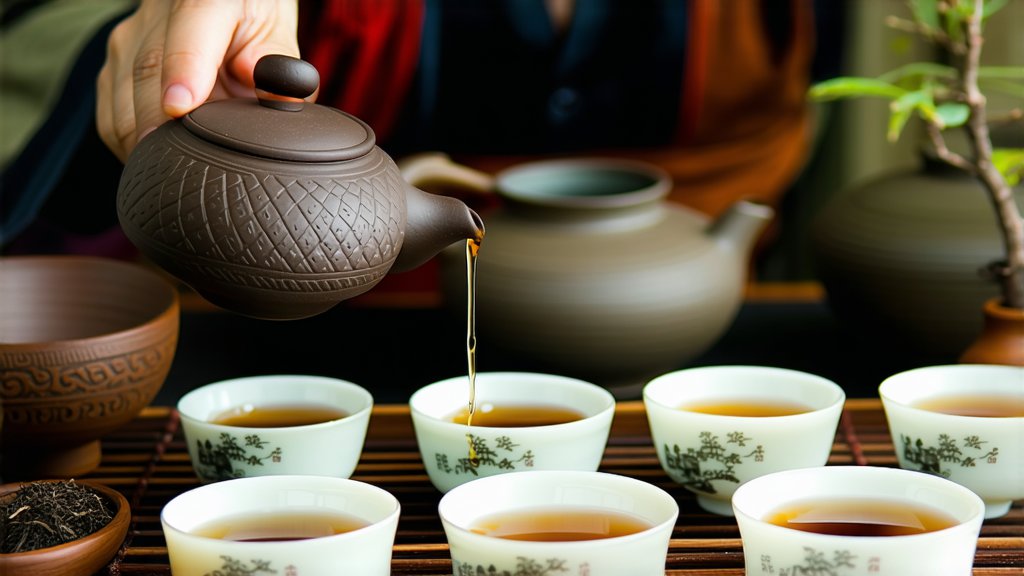
Pu-erh tea, a gem among China's dark tea varieties, holds a revered place in the annals of global tea culture. This unique tea, originating from the Yunnan province, boasts a rich history intertwined with ancient trade routes and cultural exchanges, making it not just a beverage but a symbol of historical significance. Its journey from ancient times to modern tea tables is marked by intricate processes and evolving appreciation methods that continue to captivate tea enthusiasts worldwide.
A Glimpse into History
The roots of Pu-erh tea can be traced back to the Tang Dynasty (618-907 AD), with its prominence solidified during the Ming Dynasty (1368-1644 AD) when it became a coveted commodity along the ancient Tea Horse Road. This trade route facilitated the exchange of goods between China and Tibet, with Pu-erh tea being a crucial part of this commerce due to its durability and ability to improve with age during long journeys. Over centuries, Pu-erh evolved not only as a drink but also as a form of art and investment, with aged pu-erh cakes fetching high prices at auctions.
Varieties Unveiled
Pu-erh tea is broadly classified into two main types: Raw Pu-erh (Sheng) and Ripe Pu-erh (Shou). Each type undergoes distinct processing methods that impart unique characteristics to the tea.
-
Raw Pu-erh (Sheng): This variety retains more of its natural flavors and undergoes minimal processing after picking. The leaves are sun-dried, rolled, and then compressed into various shapes such as cakes, bricks, or tuocha (nestled tea). Raw Pu-erh is known for its vibrant taste profile, which includes notes of fruitiness, floral undertones, and astringency. As it ages, these flavors mellow, transforming into complex, earthy, and sometimes musty aromas reminiscent of damp forest floors.
-
Ripe Pu-erh (Shou): In contrast, Ripe Pu-erh undergoes a post-fermentation process known as "wet piling" or "wo dui," where piles of tea are intentionally humidified and turned regularly to accelerate microbial activity. This process mimics the aging effects seen in older raw pu-erh but in a shorter timeframe. The result is a tea with a smoother, mellower taste, often described as having notes of caramel, chocolate, and earthiness. Ripe pu-erh is generally considered more approachable for beginners due to its milder flavor and less astringent nature.
The Art of Craftsmanship
The production of Pu-erh tea is a testament to the harmony between man and nature, involving meticulous steps that ensure the tea's quality and distinctiveness.
-
Picking: Only the tenderest buds and leaves are handpicked during specific seasons, usually spring and autumn, when the tea plants are at their healthiest.
-
Withering: Freshly picked leaves spread out in the sun to reduce moisture content, allowing enzymes to start breaking down complex compounds.
-
Fixation: The withered leaves are quickly heated to halt oxidation, preserving the green color and fresh aroma.
-
Rolling: The fixed leaves are rolled to release juices and shape the leaves, enhancing the tea's flavor during brewing.
-
Drying: The rolled leaves are dried again to remove excess moisture, preparing them for compression.
-
Compression (for Sheng): For Raw Pu-erh, the dried leaves are weighed and pressed into molds to form cakes or other shapes, which are then dried thoroughly before packaging.
-
Post-Fermentation (for Shou): Ripe Pu-erh undergoes an additional step of controlled microbial fermentation in a humid environment, followed by drying and aging to develop its unique flavor profile.
Savoring the Essence: Tasting and Appreciating Pu-erh Tea
Appreciating Pu-erh tea goes beyond mere consumption; it's an experience that engages all senses and invites contemplation. Here's a guide to savoring this exceptional tea:
-
Preparation: Use a Yixing clay teapot or a Gaiwan for optimal brewing. Rinse the leaves briefly with hot water to awaken their flavors and discard the initial wash.
-
Brewing: Steep the leaves in沸水 (boiling water) for Raw Pu-erh or slightly cooler water (around 95°C/203°F) for Ripe Pu-erh. Start with shorter steeping times (around 5-10 seconds) and gradually increase as subsequent infusions reveal deeper flavors.
-
Observation: Note the tea's aroma, both dry and wet (after brewing), and the color of the liquor, which ranges from bright amber to deep red-brown.
-
Tasting: Sip slowly, allowing the tea to coat your palate. Pay attention to the initial taste, mid-mouthfeel, and aftertaste. Raw Pu-erh typically offers a progression from astringency to sweetness, while Ripe Pu-erh provides a consistent, smooth experience with subtle complexity.
-
Aging Potential: One of the most fascinating aspects of Pu-erh tea is its potential to improve over time. Both Raw and Ripe Pu-erh can be cellared like fine wine, with proper storage conditions (low humidity, cool temperature, away from strong odors) enhancing their flavors and value.
In conclusion, Pu-erh tea embodies the essence of Chinese tea culture—a blend of tradition, innovation, and patience. Whether you're drawn to the vibrant vitality of Raw Pu-erh or the mellow sophistication of Ripe Pu-erh, exploring this tea offers a journey through history, craftsmanship, and personal discovery. As you delve into the world of Pu-erh, remember that each cup tells a story, inviting you to slow down, savor the moment, and appreciate the timeless charm of this extraordinary tea.